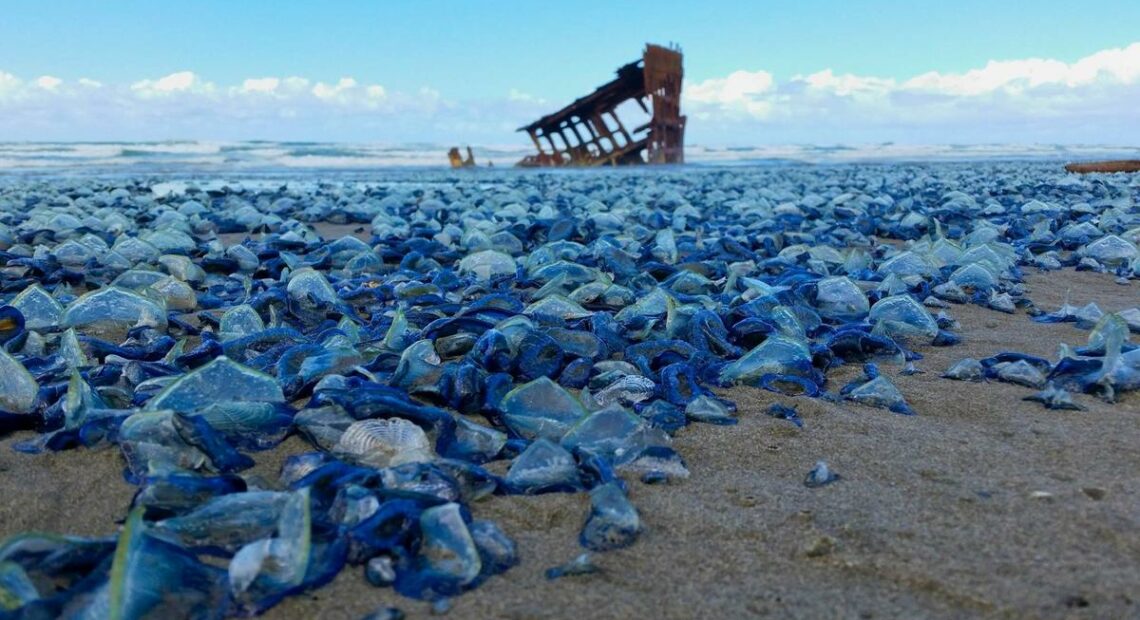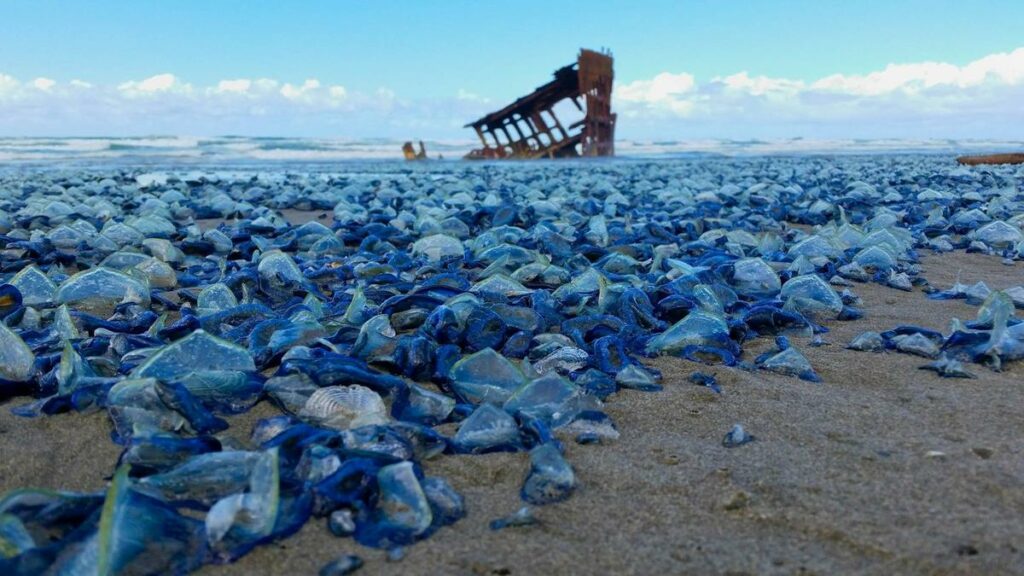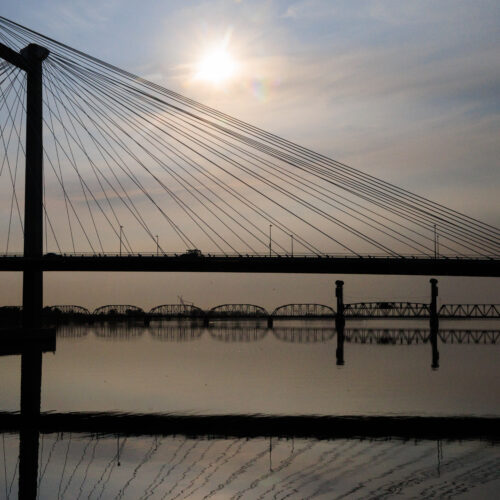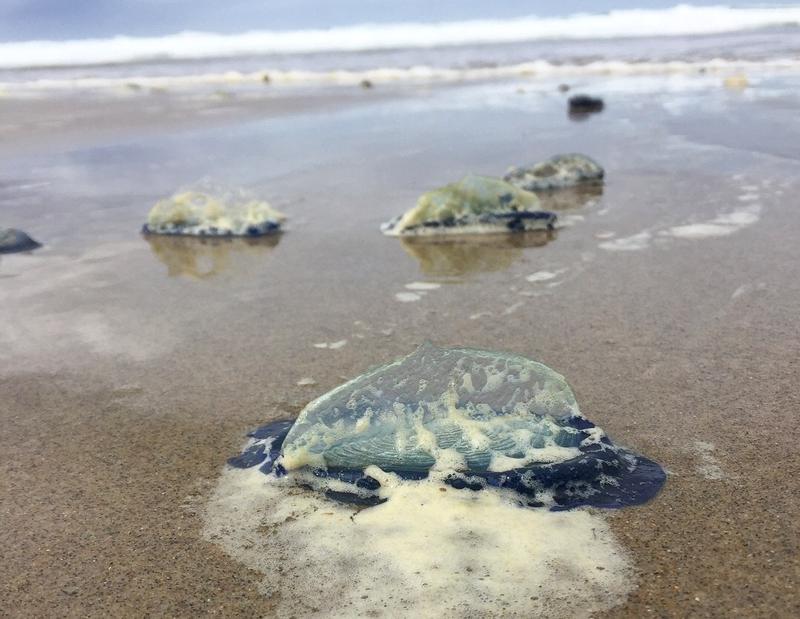
‘Blue Tides’ Of Sailor Jellies On Northwest Coast Correlate With Warmer Seas In Winter
READ ON
New research out of the University of Washington finds a correlation between warmer ocean waters and mass strandings of By-the-wind sailor jellyfish over the past two decades. The brief, widespread beachings of “gazillions” of purplish-blue jellies along the Pacific Northwest coast create a memorable sight for those who chance to be in the right place at the right time.
The Seaside Aquarium and Oregon Coast Aquarium popularized the term “blue tide” to describe what happens when onshore winds wash in countless numbers of these weird jellyfish with stubby, translucent sails. Unlike red tides, the palm-sized jellies pose no danger to humans, but their mass decay does make coastal beaches stinky for a few days.
University of Washington marine biology professor Julia Parrish said the colors in the jellies quickly fade when they wash ashore, die and dry out, but the last phase of the phenomenon is curious, too.
Parrish said it leaves the high tide line looking like it’s covered by a miles-long spill of “little, crispy potato chips.”
“If you walked on them, they would crunch,” Parrish said in an interview.
Parrish and her collaborators asked why in some springs there are mass strandings of By-the-wind sailors and other years, nothing. So, they compared citizen beachcomber reports with offshore weather and water temperature records. Warmer than normal seas in winter stood out as a key factor.
“Warmer, calmer winters may allow these guys to survive and thrive in the open ocean and create big aggregations,” Parrish explained. “Then the wind shifts, and that aggregation gets blown to shore.”

A mass stranding of Velella velella at Fort Stevens State Park, Oregon, in 2015. CREDIT: Tiffany Boothe/Seaside Aquarium
Judging by this pattern, Pacific Northwesterners probably won’t see a mass beaching this spring of Velella velella — the Latin name for the gelatinous creatures — because this past winter was on the cold side. But Parrish said the chances for blue tides are improving with climate change.
“Velella is an indicator — a sentinel organism — for change in the open ocean and for the impact of a warming climate on ocean ecosystems,” Parrish said. “Velella is a winner in the ecosystem when it’s warmer than normal.”
The research team teased out the blue tide pattern from a trove of beachcombing data collected by citizen scientists. The Coastal Observation and Seabird Survey Team (COASST) mostly takes in reports on dead marine birds from volunteer trained beachgoers who walk a stretch of coastline regularly. But the database also notes other interesting finds, which turned out to include the unusual jellyfish beachings over the past twenty years.
The research results are newly published in the peer-reviewed journal Marine Ecology Progress Series.
The scientific paper’s lead author was Tim Jones, the “numbers guy” at COASST, joined by Parrish, who is the citizen science network’s executive director and Hillary Burgess who now works with the NOAA Office of Marine Debris. The team credited the genesis of their study to a COASST volunteer observer who asked a thought-provoking question about whether the next mass stranding of jellies could be anticipated.
The analysis of beachgoer observations revealed two periods with massive stranding events in springtime, stretching from the northwest tip of Washington state down past Mendocino in Northern California. The first happened in 2003-2005 and the second wave from 2015-2019.
The second series of blue tides corresponded with a persistent pool of warmer water on the surface of the northeast Pacific Ocean offshore. This marine heat wave was colloquially dubbed The Blob. It has now dissipated.
“We had big, big strandings of Velella every spring during The Blob years,” Parrish said. “But before The Blob years, the water was normal or colder and we had many years with no Velella.”
Every now and then, the sailor jellies will also wash ashore in the fall when the prevailing wind direction shifts to blow out of the west.
These jellies can’t swim, but they can sail using the stiff, triangular protrusion from their bodies which gives them their common name of By-the-wind sailors. These sails allow the creatures to zip around the surface of the open ocean far offshore in pursuit of food. With their tentacles, they catch plankton and fish eggs to eat.
Related Stories:

How does climate affect your life? Tri-Cities survey open now
Cities, towns and counties are starting to plan for a future with climate change. Now, the Tri-Cities area is asking people about regional hazards and historical trends. (Credit: Simon Foot

Canadian leaders hope trade negotiations won’t derail Columbia River Treaty
A view of the Columbia River in British Columbia. The Columbia River Treaty is on “pause” while the Trump administration considers its policy options. However, recent comments by President Donald

Searching for sage grouse: Looking for a chicken-sized needle in south-central WA
Seth Hulett, Audubon Washington’s senior program manager of the Columbia Plateau, searches through his spotting scope for sage grouse. (Credit: Courtney Flatt / NWPB) Listen (Runtime 4:12) Read In south-central















